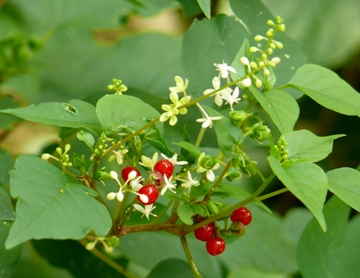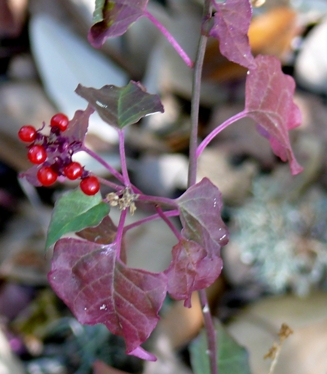After “Do deer eat it?”, probably the second-most-common question asked by Hill Country gardeners wanting to grow native plants is “What can I plant in the shade under the live oaks?”. For the answer to that, look no farther than the Operation NICE! (Natives Instead of the Common Exotics!) plant for July-August. The summer selection is pigeon-berry (Rivina humilis).
This tough little perennial makes an attractive border plant or ground cover in shady areas. It grows in low clumps with dark-green wavy-edge leaves. During much of the growing season, it supports short stalks of small pinkish-white flowers and red berries, both at the same time. In late fall, the leaves and stems turn purplish-red.

Pigeon-berry only gets up to about one and a half feet high in our yard of dry, poor soil, but I’ve seen it almost twice that tall in the wild.
Rivina is a one-species genus of the pokeweed family, and it ranges from across the southern US to Arizona and through Central America and the Caribbean to South America. In Texas is has been collected from the Red River Valley, throughout Central and South Texas, and out to the Trans-Pecos.
The wide distribution of this species indicates it can grow in a wide variety of soil types and moisture conditions. It does fine in the limestone terrain of the Hill Country, especially in moist stream-valley woods and thickets.
Surprisingly, pigeon-berry in our yard is surviving nicely during this prolonged scorching heat wave. It is one of the few natives still blooming in our garden, and it has not had special irrigation. Our pigeon-berry is planted in shady areas, and I doubt it would survive so well in hotter sunny spots.

Pigeon-berry is commonly available in local nurseries. The Boerne Chapter of the Native Plant Society of Texas provides free planting and care instructions for pigeon-berry at nurseries participating in Operation NICE! (Hill Country African Violets and Nursery and Maldonado Landscape and Nursery) and at the Cibolo Nature Center.
Southwestern Native Americans supposedly used the fruit of pigeon-berry to make red dye. In Mexico, pigeon-berry leaves were used to treat wounds. There is some evidence from a study of leaf extracts that the leaves are weakly effective in reducing growth of certain bacteria.
Leaves and roots and probably the berries of pigeon-berry are poisonous to the gastrointestinal system. Perhaps that explains why deer in our subdivision seem reluctant to browse this plant most of the year. Lately, however, some of our plants have been snipped by deer, and friends in other subdivisions with over-populated deer have lost their pigeon-berry to browsers.
In our native-plant gardens, pigeon-berry is a nice companion plant to mountain sage (Salvia regla). It also looks good among cedar sage (S. roemeriana) and tropical sage (S. coccinea). Pigeon-berry can be used as a ground cover under taller plants such as American beautyberry (Callicarpa americana) and Mexican buckeye (Ungnadia speciosa). Pigeon-berry would be a complementary addition to any native-plant woodland garden.


